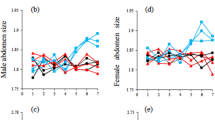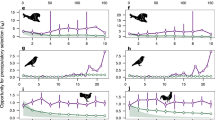Abstract
A long-standing hypothesis1,2 posits that natural selection can favour two female strategies when density cycles. At low density, females producing many smaller progeny are favoured when the intrinsic rate of increase, r, governs population growth. At peak density, females producing fewer, high-quality, progeny are favoured when the carrying capacity, K, is exceeded and the population crashes. Here we report on the first example of a genetic r versus K selection3,4,5 game that promotes stable population cycles in lizards. Decade-long fitness studies and game theory demonstrated that two throat-colour morphs were refined by selection in which the strength of natural selection varied with density. Orange-throated females, r strategists, produced many eggs and were favoured at low density. Conversely, yellow-throated females, K strategists, produced large eggs and were favoured at high density. Progeny size should also be under negative frequency-dependent selection in that large progeny will have a survival advantage when rare, but the advantage disappears when they become common. We confirmed this prediction by seeding field plots with rare and common giant hatchlings. Thus, intrinsic causes of frequency- and density-dependent selection promotes an evolutionary game with two-generation oscillations.
This is a preview of subscription content, access via your institution
Access options
Subscribe to this journal
Receive 51 print issues and online access
$199.00 per year
only $3.90 per issue
Buy this article
- Purchase on Springer Link
- Instant access to full article PDF
Prices may be subject to local taxes which are calculated during checkout




Similar content being viewed by others
References
Chitty, D. Regulation in numbers through changes in viability. Can. J. Zool. 38, 99–113 ( 1958).
Chitty, D. Population forces in the vole and their relevance to general theory. Cold Spring Harb. Symp. Quant. Biol. 22, 277– 280 (1960).
MacArthur, R. H. & Wilson, E. O. Theory of Island Biogeography (Princeton Univ. Press, Princeton, 1967 ).
Pianka, E. R. On r- and K-selection. Am. Nat. 104, 592–597 (1970).
Stearns, S. C. The Evolution of Life Histories (Oxford Univ. Press, Oxford, 1992).
Sinervo, B. in Maternal Effects as Adaptations (eds Mousseau, T. A. & Fox, C. W.) 288–306 (Oxford Univ. Press, Oxford, 1998).
Sinervo, B. & Lively, C. M. The rock-paper-scissors game and the evolution of alternative male strategies. Nature 380, 240–243 (1996).
Svensson, E. & Sinervo, B. Experimental excursions on adaptive landscapes: density-dependent selection on egg size. Evolution (in the press).
Lande, R. & Arnold, S. J. The measurement of selection on correlated characters. Evolution 36, 1210 –1226 (1983).
Boag, P. T. & Grant, P. R. Intense natural selection in a population of Darwin's finches (Geospizinae) in the Galapagos. Science 214, 82–85 ( 1981).
Endler, J. A. Natural Selection in the Wild (Princeton Univ. Press, Princeton, 1986).
Gibbs, H. L. & Grant, P. Oscillating selection on Darwin's Finches. Nature 327, 511– 513 (1987).
Sinervo, B. & DeNardo, D. F. Costs of reproduction in the wild: path analysis of natural selection and experimental tests of causation. Evolution 50, 1299–1313 (1996).
Chatfield, C. The Analysis of Time Series. An Introduction (Chapman & Hall, London, 1992).
Rice, W. R. A consensus combined P-value test and the family-wide significance of component tests. Biometrics 46, 303– 308 (1990).
Brodie, E. E. III Correlational selection for color pattern and antipredator behavior in the garter snake Thamnophis ordinoides. Evolution 46, 1284–1298 ( 1992).
Maynard Smith, J. Evolution and the Theory of Games (Cambridge Univ. Press, Cambridge, 1982).
Sinervo, B. in Model Systems in Behavioral Ecology (ed. Dugatkin, L.) (Princeton Univ. Press, in the press).
Zeng, Z., Nowierski, R. M., Taper, M. L., Dennis, B. & Kemp, W. P. Complex population dynamics in the real world. Modeling the influence of time varying parameters and time lags. Ecology 79, 2193–2209 (1998).
Sinervo, B. & Basolo, A. in Adaptation (eds Rose, M. R. & Lauder, G. V.) 148–185 (Academic, New York, 1996).
Sinervo, B., Doughty, P., Huey, R. B. & Zamudio, K. Allometric engineering: a causal analysis of natural selection on offspring size. Science 258, 1927–1930 ( 1992).
Sinervo, B. in Adaptive Genetic Variation in the Wild (eds Mousseau, T., Sinervo, B. & Endler, J. A.) 41–64 (Oxford Univ. Press, Oxford, 2000).
Cooper, W. E. & Greenberg, N. in Hormones, Brain, and Behavior. Biology of the Reptilia (eds Crews, D. & Gans, C.) 298– 422 (Academic, New York, 1992).
Wallace, B. Genetic Load, its Biological and Conceptual Aspects (Prentice Hall, New Jersey, 1970).
Smith, C. C. & Fretwell, S. D. The optimal balance between size and number of offspring. Am. Nat. 108, 499–506 (1974).
Brockelman, W. Y. Competition, the fitness of offspring, and optimal clutch size. Am. Nat. 109, 677–699 ( 1975).
Sinervo, B. & Licht, P. Proximate constraints on the evolution of egg size, egg number, and total clutch mass in lizards. Science 252, 1300–1302 ( 1991).
Sinervo, B. & Huey, R. B. Allometric engineering: an experimental test of the causes of interpopulational differences in locomotor performance. Science 248, 1106–1109 (1990).
Acknowledgements
We thank O. Bjornstad, C. Both, R. Calsbeek, A. Chaine, D. Croll, D. Doak, J. Estes, G. Pogson, N. Janzen, D. Kellogg, P. Lundberg, B. Lyon and J. Vogelzang for comments. Research was supported by NSF grants to B.S. and STINT, Fullbright, and NFR grants to E.S. We thank P. Stadler and R. Schrimp for permission to work on their land.
Author information
Authors and Affiliations
Corresponding author
Rights and permissions
About this article
Cite this article
Sinervo, B., Svensson, E. & Comendant, T. Density cycles and an offspring quantity and quality game driven by natural selection. Nature 406, 985–988 (2000). https://doi.org/10.1038/35023149
Received:
Accepted:
Issue Date:
DOI: https://doi.org/10.1038/35023149
This article is cited by
-
Regulation of insect behavior by non-coding RNAs
Science China Life Sciences (2024)
-
Effects of natural selection by fertility on the evolution of the dynamic modes of population number: bistability and multistability
Nonlinear Dynamics (2020)
-
Hunting regulation favors slow life histories in a large carnivore
Nature Communications (2018)
-
Evolution of sex-specific pace-of-life syndromes: genetic architecture and physiological mechanisms
Behavioral Ecology and Sociobiology (2018)
-
Male nutritional history affects female fecundity in a male-dimorphic mite: Evidence for a nuptial gift?
Evolutionary Ecology (2018)
Comments
By submitting a comment you agree to abide by our Terms and Community Guidelines. If you find something abusive or that does not comply with our terms or guidelines please flag it as inappropriate.



